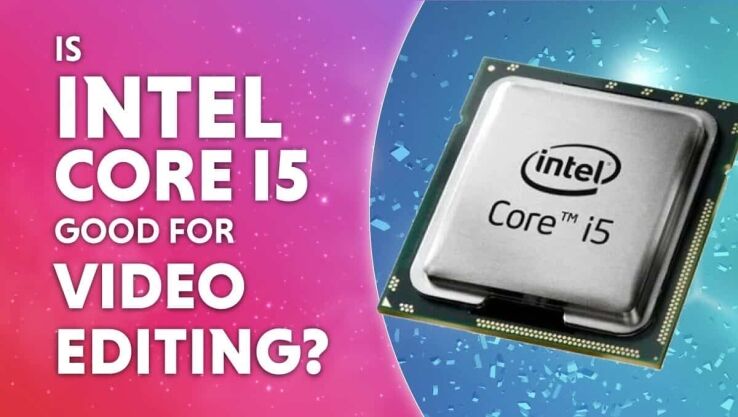Is Intel i5 good for video editing in 2024? Here’s what you need to know
Is Intel i5 good for video editing? let's find out.

WePC is reader-supported. When you buy through links on our site, we may earn an affiliate commission. Prices subject to change. Learn more
Is Intel i5 good for video editing? Intel core i5 is the company’s mid-range offering – but it still has plenty of horsepower. It has always been a favorite among budget-conscious users, but we saw it explode in popularity with the release of the new Raptor Lake i5s in Q4 2022.
Core i5 processors are now considered a top option for gamers and streamers due to their upgraded specs. Let’s find out whether or not they make good video-editing CPUs as well. We’ve pulled together a few products for you, including a budget and top-end i5-CPU if you’re looking for a simple upgrade. If you’re after something more powerful, check out the best CPUs for gaming.
What makes a CPU good for video editing?
Video editing is a CPU-centric workload. There are a certain few programs out there that are able to utilize more of the GPU to carry out editing. However, they are the exception. You’ll need to have a strong CPU to run video editing software smoothly and be productive with your video editing tasks.
A high core and thread count
Modern processors contain several smaller cores built onto them. The more cores, the more tasks the processor can handle simultaneously. A thread is like a virtual core. Intel’s hyperthreading technology allows a single core to serve two threads, which increases the processor’s multitasking ability even further.
Now, you’re probably wondering why this matters for video editing. See, the thing is, video editing, as a process, can easily be broken down into many multiple smaller processes. Video editing applications can break the CPU’s workload down into chunks and delegate it to all the available threads, making for some very efficient multicore processing.
A high thread count directly translates to a faster processing speed for video editing purposes, which is why it’s the most desirable trait to have in a processor. 16 threads is a solid benchmark for a video-editing processor. The more the better, though. We even have several 32-thread consumer-grade processors today, and needless to say, they make quick work of video-editing-related processing.
High clock speed
A CPU’s clock speed is essentially how many instructions it can execute per second. A higher clock speed is desirable since it directly equates to faster processing. Clock speed and processing times scale linearly. Older processors had clock speeds of 3GHz and above. CPUs released within the past few years feature 4GHz and above clock speeds.
Is the Intel core i5 series good for video editing?
Core i5-12400F
Cores:
6
Threads:
12
Base clock speed:
2.50 GHz
Boost clock speed:
4.40 GHz
TDP:
65 W
- Decent performance for the price
- Prices will continue to drop
- Some way behind the 13th Gen i5
With the above in mind, is the Intel core i5 good for video editing? We can break core i5 processors down into four generational categories, roughly speaking. Generations one to seven saw single-threaded quad cores with clock speeds of 3 to 4GHz. Although their core clock was acceptable, they lacked the thread count to be viable video editing processors. When generation 8 and 9 arrived, these i5s had six single-threaded cores – 6 cores and 6 threads. That was a step up from the quad-core processors but was still lacking.
In fact, it wasn’t until generation 10, 11, and 12 that we started to really impressive performance. These i5 processors have six hyperthreaded cores, meaning 12 threads. With 12 threads they’re able to offer decent multithreaded performance, and as such, can be used for video editing. The choice above, which can be picked up as a bargain now that the 14th Gen is out, could serve you well. However, I would still recommend going for an i7 processor of the same generation for even more threads.
Intel Core i5-13600K
Intel Core i5-13600K
Cores
14
Threads
20
Base speed
P-cores 3.5 GHz / E-cores 2.6 GHz
Boost speed
P-cores 5.1 GHz / E-cores 3.9 GHz
Cache
20MB
TDP
125 W / 181 W boost.
- High core count for an entry level CPU
- High base and boost speeds
- Efficient
- backwards compatible with 12th gen motherboards
- Runs very warm
Generation 13, which has since been surpassed by the 14th Gen, saw the Core i5 receive a huge upgrade, thanks to Intel’s LITTLE.big architecture. The 13400 had 10 cores and 16 threads. The 13600K had 14 cores and 20 threads. These thread counts were incredible for an i5, and they’re very powerful video editing processors. This is a great option if you have a slightly larger budget.
Final word
To sum it up, Core i5 processors generation 1 to 9 aren’t viable for video editing. Generations 10 to 12 are far better and will offer you decent performance. I would highly recommend going for a 13600K to get top-notch productivity at a mid-range price point. It’s not just the best i5, but one of Intel’s best processors overall, for video editing.